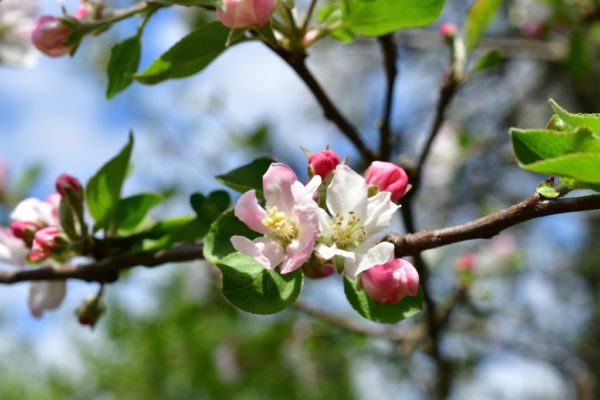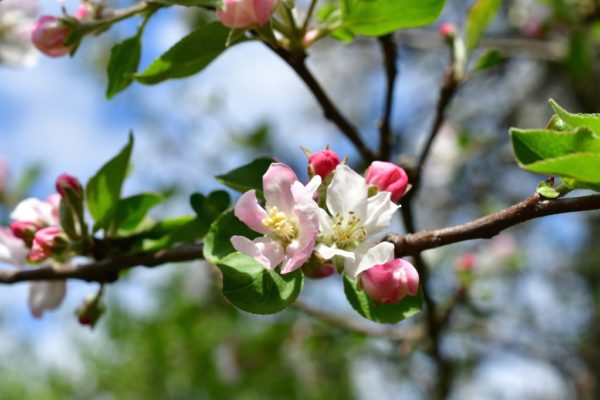

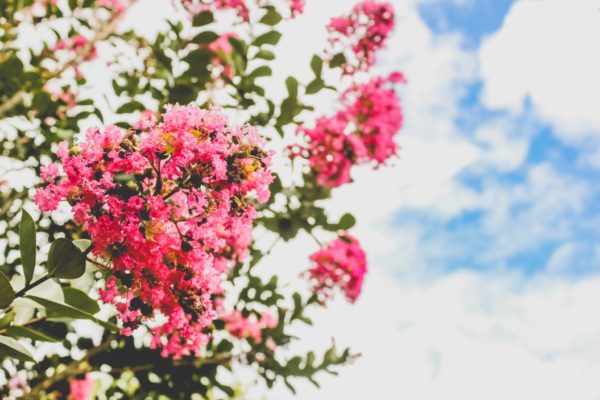
Spring season is that wonderful time of the year when colorful blooms begin to flourish throughout many parts of the world. But in the city of San Diego, we have the luxury of being able to enjoy flowering plants and trees all throughout the year due to our mild and sunny climate. In fact, many landscapers and property owners strategically plan their landscape so that there is always a flowering plant or tree from winter through autumn. As one tree’s flowering season ends, another one begins.
Whether you’re looking to add a flowering tree to your property or just plain curious, we’ve compiled a list — in no particular order of popularity — of what we consider to be the most common flowering trees in San Diego.
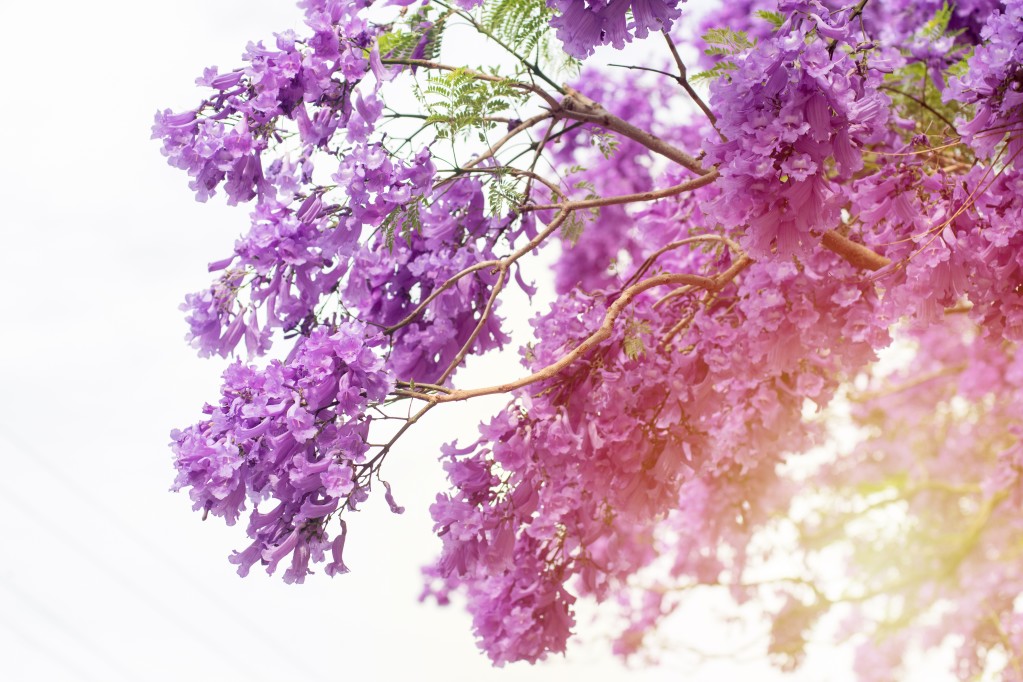

1
JACARANDA
Jacaranda mimosifolia
Jacarandas are one of San Diego’s most spectacular flowering trees. In late spring into the summer months, it’s hard to go a day driving through town without seeing at least one jacaranda and its popular lavender, bell-shaped blooms. These flowers grace us with their presence for two months before falling and creating a carpet of color on the ground beneath.
When not in bloom, the jacaranda is still one of San Diego’s finest-looking ornamental trees. Once established, it’s a fast-growing tree that develops a bright green canopy of fern leaves against the tree’s grayish-brown limbs. It grows fast, but its size at full maturity is quite manageable because it typically only grows to roughly 25 to 40 feet in height, with similar dimensions in canopy spread. The jacaranda is also a popular choice with urban planners due to its “pavement friendly” roots, which, unlike some other common trees like the ficus benjamina, is less likely to damage sidewalks and streets.
There are many wonderful features associated with the jacaranda, but even this beauty can’t be perfect in all aspects. Unfortunately, the jacaranda is a deciduous tree, which means that it loses its foliage every year. So for the winter months, you’re left with an arrangement of bending grey wood in your outdoor space. But hey…neutral colors are all the rage…so apparently it works. As the weather begins to warm up, the tree’s foliage slowly fills the canopy with yellowish-green leaves. It looks sparse and a little sickly, depending on the tree. Not very appealing, to say it nicely — but when the warmest and sunniest season arrives, the jacaranda’s beauty shines once again with its lush green canopy, followed by its magnificent purple blooms.
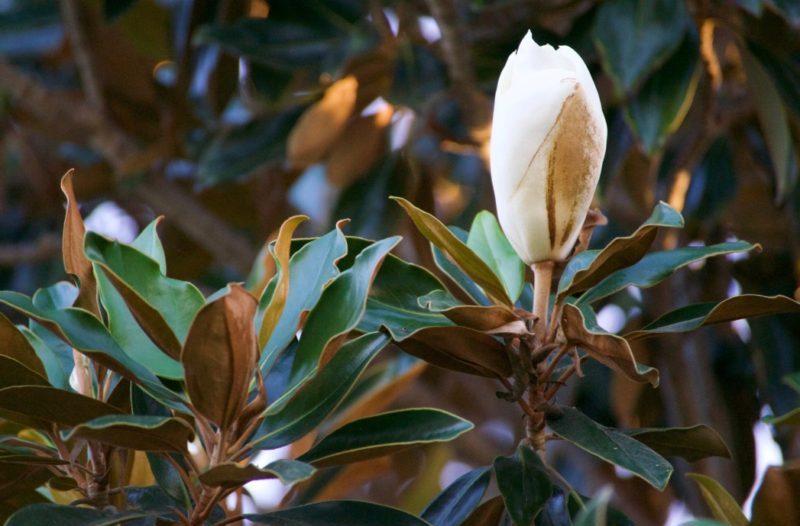
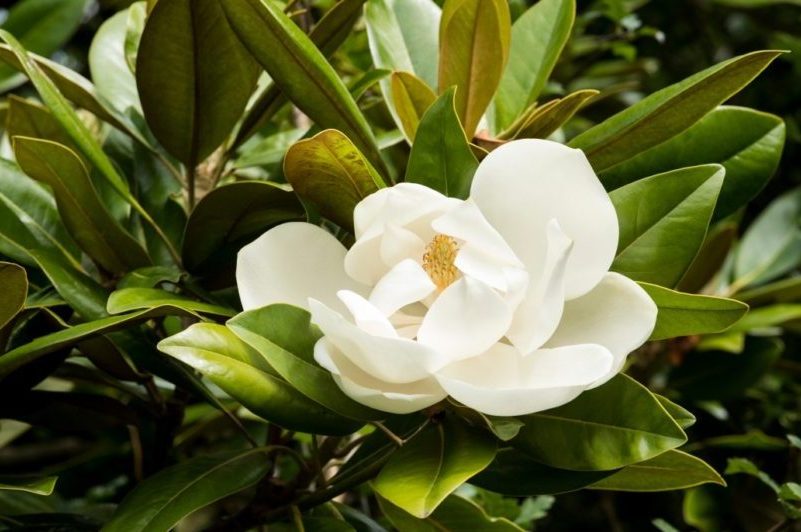
2
MAGNOLIA
Magnolia grandiflora
The magnolia tree is a very well-known name in the flowering tree category. For all you home decorators, think Joanna Gaines and her popular Magnolia Homes company. But what many do not know is that it is also the most ancient flowering plant that we know of according to fossil records. Surviving through ancient history, there are more than 200 magnolia species that originated mostly in Asia and in the Americas. They are common trees throughout the world, especially in sub-tropical and tropical regions, and are known for their stunning flower display with pink, purple, white, and even yellow blooms.
The most common magnolia in Southern California is the Southern magnolia. It possesses large evergreen leaves that exhibit a deep green color and a unique brownish touch. Then in the late spring and into the summer, the Southern magnolia unveils its beautiful, large, white flowers that contrast so well against its green foliage backdrop. When we say large, we mean large, as the oval-shaped leaves typically range from 5-8 inches in length, and its fragrant flowers possess an 8-inch diameter range.
Compared to the other popular flowering trees on this list, the Southern magnolia is a rather slow-growing tree and is known to take up to 10 years after planting to even blossom. So patience is required! But it won’t stay little forever. It typically matures to a height of 60-80 feet with a canopy spread of roughly 40 feet, and in its most ideal conditions, it even grows taller than 80 feet!
When it comes to trimming a magnolia tree, great news! They don’t require much. But the bad news is that these trees are FINICKY! Trim your tree at the wrong time of the year, and you can kiss the next year’s beautiful flower display goodbye. Even worse, given the right candidate, you could end up killing your tree. Magnolias, especially mature ones, tend to have a hard time recovering from injuries. The best time to trim them is right after its flowering season so that it has sufficient time to heal before winter. Otherwise, trimming a magnolia during the wrong season can result in excessive bleeding, which could weaken the tree and leave it vulnerable.
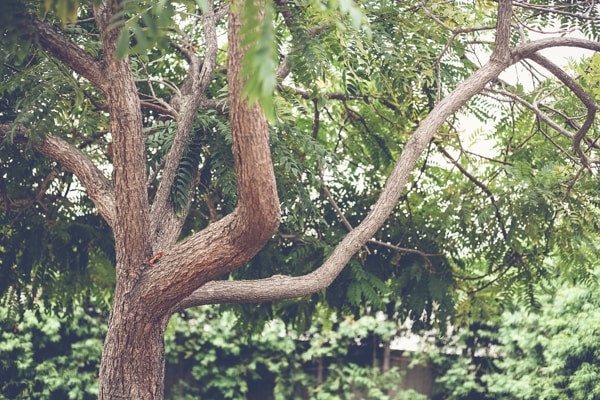
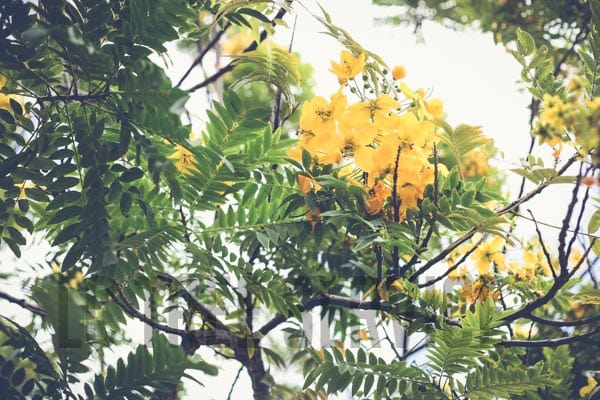
3
TIPUANA TIPU
Tipuana tipu
Native to South America, the Tipuana tipu, or tipu for short, is one of San Diego’s most popular trees. When not in bloom, it can often be mistaken for the jacaranda, since the two have very similar structures and fern-like foliage. Even arborists, at a distance, may need a moment to determine who’s who. However, once its sunny yellow flowers emerge in the spring and into the summer, there’s no mistaking the two trees.
With its roots in a tropical homeland, the tipu thrives in areas with plenty of warm sunlight, so make sure to plant it in a location with full sun. It loves the heat and can handle San Diego’s hot and dry summers extremely well. This is why it is also a popular choice for desert communities.
The tipu is a choice selection for properties and urban development throughout San Diego due to its rapid growth, pavement-friendly roots, drought resistance, and flowery display. It’s perfect for all you impatient folks who don’t want to wait 10 years for their newly-planted young tree to provide ample shade and a majestic presentation. And even better, if you’re not interested in a huge tree, the tipu is a great choice, as they are medium-sized trees that are usually seen in the 30-50ft range with a wide canopy spread that matches its height.
The Tipuana tipu is a fast-growing tree that typically grows 2-3 feet a year! A young tree has the potential to quickly develop a canopy width of 20 feet just a few years after being transplanted. Due to this rapid growth, it’s important to keep your tipu on a regular trimming schedule. Otherwise, the tree ends up looking like an unkempt child with neverending bedhead. But when properly trimmed, the tipu has the potential of looking amazing — whether it’s covered with yellow blooms or not!
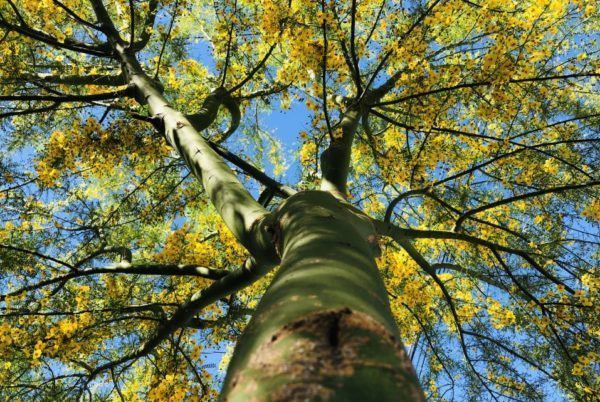

4
PALO VERDE
Parkinsonia florida, Parkinsonia microphylla, Cerdium ‘ Desert Museum’
The palo verde is another common yellow-blooming tree in San Diego. The name in Spanish means green stick because, as you can guess, it possesses limbs that are green! It’s a unique sight, especially with its yellow blooms that complement the green so well. As the palo verde matures, its trunk and mature branches eventually turn brown, but any new limbs grow out green. Why green? The bark of the palo verde is uncommonly filled with chlorophyll, which allows it to participate in photosynthesis — a job that is normally assigned to the leaves. But for this green wonder, its foliage only contributes one-third of the tree’s food.
Even with its unconventional green limbs and showy flowers that allure people, the palo verde is still one of those trees that you either love or hate. It’s actually a tree that tree trimmers can’t stand! Why? Because these trees are notorious for pain! Yes, their green branches are awesome to look at, but with close examination, you’ll realize that they’re covered with sharp spikes. It’s a desert tree, and it seems to have copied the same spiky qualities of its desert best friend (the cactus, of course). It’s like middle school cliques dressing the same. “Make sure to wear your spikes on Friday!”
As with any tree, one of the palo verde’s goals is reproduction. No harm there. However, this tree is like the “rabbit of the tree world.” Palos love to procreate, and they’re good at it. If left unmanaged, a single tree on a property can multiply into a grove of more than 20 palo verdes in less than 10 years. Also, the tree’s cute and innocent-looking babies don’t go without a fight. Remember those spikes? If you simply go in to pull a baby palo out with bare hands, chances are you’ll get stabbed. It is best to carefully pull at the base where spikes tend to not grow or to use pliers.
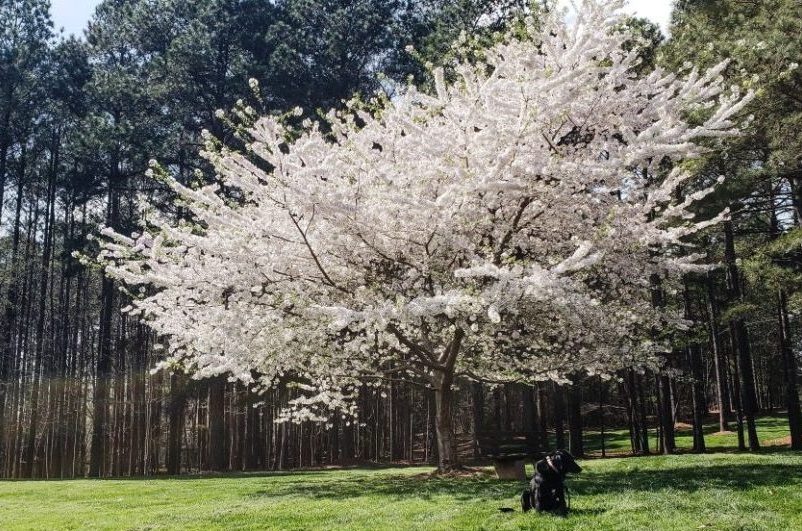
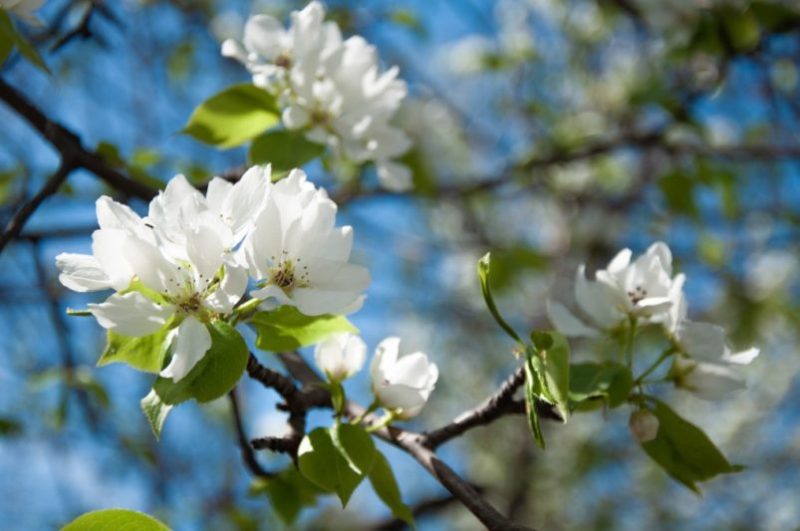
5
EVERGREEN PEAR
Pyrus kawakamii
Native to Taiwan, the evergreen pear is one of San Diego’s standout trees. Is it because it produces a vibrant colorful display of flowers like other trees on this list? No. Does it have delectable juicy pears to eat? No, again. So what’s so special about the evergreen pear? While this tree doesn’t boast of colorful springtime blooms or delicious fruit to eat, it “sticks out of the crowd” due to its distinct flowering season. In the winter, when other trees, like the jacaranda and palo verde, are plain and bare, the evergreen pear showcases its large clusters of white blossoms. It’s a wintry display that’s very appropriate to the season. We may not get snow in the streets of Downtown San Diego or our famous Balboa Park, but we get snow-white laden trees!
The evergreen pear, despite what the name implies, is not an evergreen. It is called an evergreen tree because it has a very short dormant period, causing some people to label it semi-deciduous. In the fall, its foliage morphs to an orangish-red, which drops shortly afterward. Fortunately, it only stays bare for a short period because soon afterward, its canopy becomes engulfed in showy white blooms through the rest of the cold winter season. Then at the end of winter or stretching into spring, the flowers fall to the ground and create a lovely frosty carpet.
The evergreen pear tree — despite its name — does not produce sweet pears for people to eat. Instead, it grows little, brown, inedible fruit that can create a messy nuisance during drop season.
So to sum it up — the evergreen pear is not an evergreen tree, and it doesn’t produce edible pears. Evergreen pear. Just a bit of a misnomer…just a tad.
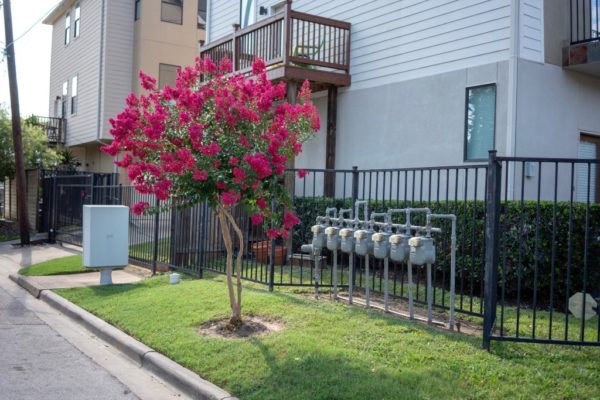
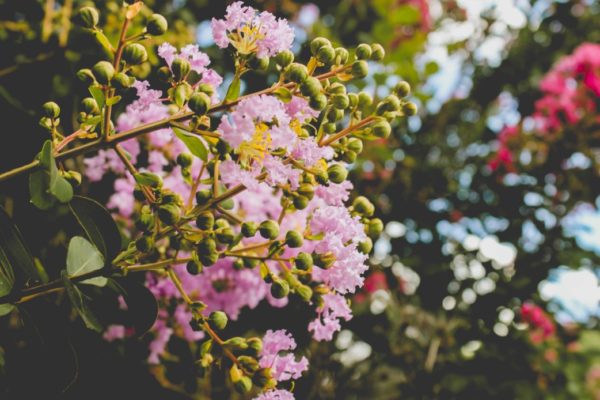
6
CRAPE MYRTLE
Lagerstroemia
The crape myrtle tree, also spelled crepe mrytle, is one of San Diego’s most beautiful flowering trees. It’s a dainty little thing that can be found in different varieties with differing height potentials. It ranges from the “very dwarf” varieties that only mature to a range of 1-3 feet to the regular-sized crape myrtles that “soar” to 20 feet. Then there are the varieties in between — dwarfs, semidwarfs, and small. Crape myrtle trees possess colorful flower clusters available in red, pink, lavender, purple, or white. These fragrant flowers grow in puffy clusters that end up dominating the tree’s canopy in the summer and create beautiful displays in San Diego’s landscape.
The crape mystle’s origins take root in China, where it was named “Pai Jih Hung” — meaning hundred days red. Why? Because the crape myrtle has an amazingly long flowering season that lasts 3-4 months! Quite impressive when you consider that the jacaranda tree’s bloom season lasts 2 months, and the magnolia’s flowers appear for a whopping 7-9 days! While the tree was originally named after its long bloom season, here in the United States, it derived its name from the crinkly appearance of its flowers, which resemble crepe paper.
Aside from its stunning display, the crape myrtle has other features that make it a great tree to add to your property. It is unfazed by the hot summer days and drought conditions. But make sure not to test your crape myrtles heat and drought endurance until its roots are well-established. This tree loves the sun, so also make sure to plant it in an area that receives plenty of sunshine. Otherwise, you may have to miss out on its colorful blooms, as it may not produce flowers if it doesn’t receive enough direct sunlight.
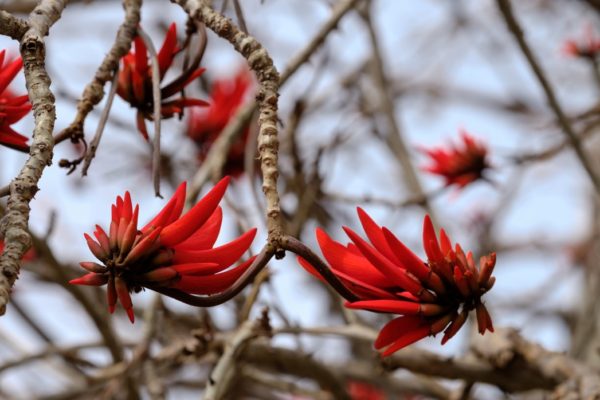
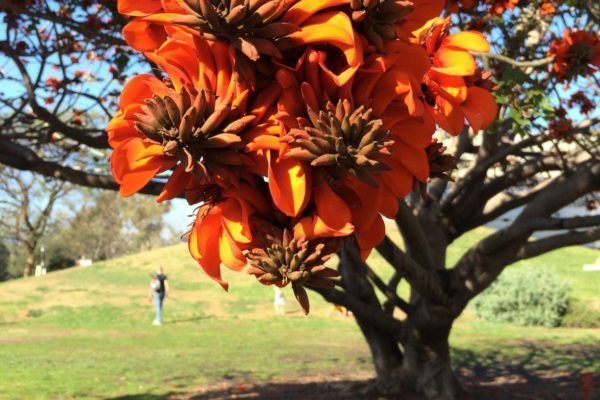
7
CORAL TREE
Erythrina
This next tree shares a striking resemblance to ocean corals. We’re talking about the coral tree, of course — a common and fitting sight for beach-loving San Diego. With roughly 130 species of coral trees (Erythrina), this is a popular tree, not just in California, but in temperate, subtropical, and tropical zones worldwide. It even happens to be the national flower of Argentina and Uruguay.
While many coral trees love the tropical heat (as you can see from their places of origin), quite a few do well in San Diego’s semi-arid climate. About a dozen Erythrina species call San Diego home. These include the naked coral from Mexico, the coastal coral and Tambookie thorn coral from Africa, and the Erythrina x sykesii from Australia. And as heat-loving trees, you might have guessed that coral trees require full-sun exposure to thrive, so make sure to plant accordingly, and don’t worry when it gets over 100° outside. Your coral tree is in “sunshine buffet heaven.”
Our local coral trees are distinguishable by their long, thick secondary branches that stem from a SHORT trunk. Some trunks are so short that they seem to barely rise up out of the ground. But just because it posses a short trunk, it doesn’t mean that the rest of the tree stays short, as it has an average height of 20-40 feet and a wide canopy width of 40-60 feet.
When the tree’s branches start at a low point, it looks like the perfect climbing tree for children. But it’s actually deceiving because the coral tree is notorious in the tree service industry for its susceptibility to breakage and tree failure. This is due to its brittle wood, poor structure, and tendency to form included bark, which is basically a weak junction between two limbs that is prone to splitting given the right amount of pressure. So the coral tree is definitely not the tree you would want to build a treehouse in or hang a swing on. Not to mention, some species also have thorns protruding from their trunk and stems.
Now to the flowers. The coral tree’s blooms are in a class of their own. With their fiery-red color and finger-like appearance, the name Erythrina actually stems from the Greek word for red — erythros. Most Erythrina species develop large, red flowers, but some also display deep orange blooms. When most flowering trees in San Diego flaunt white, yellow, or soft hues of pink or purple, the coral tree’s brilliant red makes this tree’s flower presentation an exotic attention-grabber. You can also see its blooms earlier than other trees due to the coral tree’s tendency to display its flowers in the early spring, as opposed to late spring, like most of the other flowering trees in San Diego.
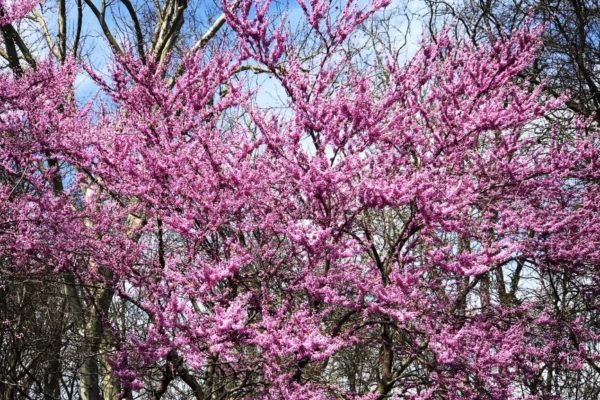
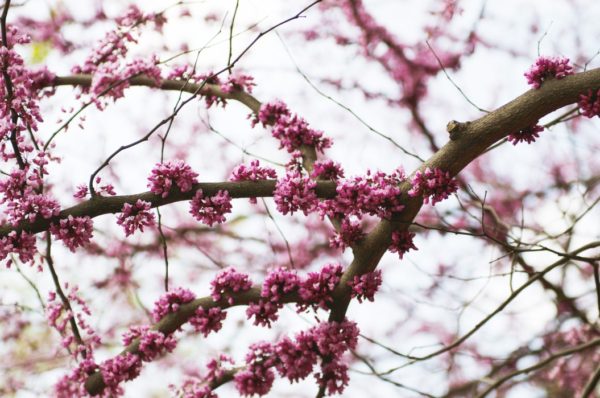
8
WESTERN REDBUD
Cercis occidentalis
Some flowering trees, such as the magnolia and mimosa trees, still retain a good portion of their foliage during bloom season. Other trees become immersed in blooms. The Western redbud is one of those trees. In the spring, hordes of purplish-pink flowers sprout all along the tree’s limbs which last for 2-3 weeks.
There are over 10 redbud species throughout the world, but only two are native to North America. As you may have already guessed, the Western redbud originates from the American Southwest — more specifically from southern Utah, Nevada, Arizona, and California. In fact, it has even been named the California redbud, as it’s a native tree that you can find in canyon bottoms, creeks, and other areas with moister soil in California.
Growing to a height of only 10-20 feet and 10-15 feet wide, the Western or California (whichever name floats your boat) redbud is a great choice for anyone desiring a small tree with pastel-colored blooms. This truly is a springtime tree because unlike many of San Diego’s other flowering trees that hold onto their blooms until summer, the Western redbud typically only possesses its flowers from March to May. It really does scream, “Springtime is here!” with its showy flaunting of pink and purple hues.
The Western redbud is a tree that loves the seasons. In the spring, it bedazzles us with its lovely flowers. Then it drops its blooms to make way for its green, heart-shaped foliage, all ready to soak up the hot sun in the summer. In the fall, the green foliage transforms into comforting autumn colors, which eventually drops toward the end of the year to expose a naked “winter-looking” tree. But be patient, because like clockwork, when the first month of spring comes around, so will those charming blooms!
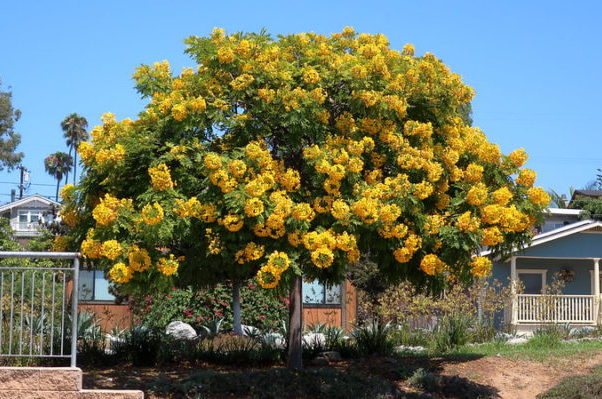
Photo credit: cultivar413
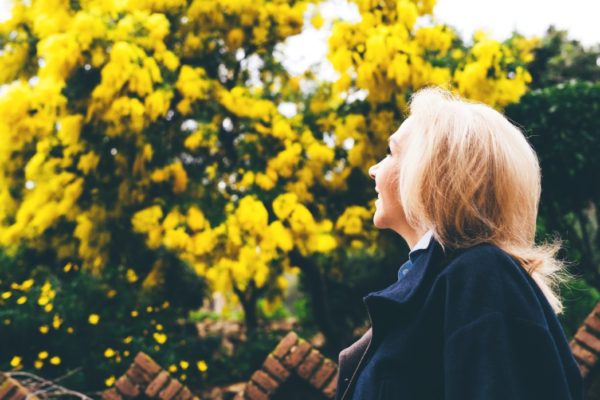
9
GOLD MEDALLION TREE
Cassia leptophylla
The gold medallion tree showcases an explosion of yellow pom-poms during San Diego’s summer months. With its basketball-size flower clusters growing on the ends of its limbs, it truly does look like an explosive fireworks display!
Stemming from Brazil, this is a tropical tree that does best in tropical climates, but still manages to flourish in San Diego’s dry climate. If you’ve visited some of the tropical regions in the United States, the gold medallion probably reminds you of some of the trees from those states. That’s because it has two very popular cousins — the golden shower tree that is so common in the South and the rainbow shower tree that populates the Hawaiian Islands. Both have amazing flower spectacles and so does the gold medallion tree! It’s a family trait.
The gold medallion is a fast-growing tree that sprouts to about 20-25 feet in height, with an average canopy spread of 20-30 feet that is composed of long compound leaves. Being a tropical tree, it does well through San Diego’s heat spells and requires a planting location that receives full sun. After being translated, the gold medallion will require a frequent water schedule until its roots become well-established. Then it will require less water and will tolerate drought conditions very well.
Like other common flowering trees in San Diego, the gold medallion is a member of the legume family, so after the flowers drop, LOOOONG brown seed pods that can grow to about two feet in length begin to take over the canopy. Not too pretty of a sight when you see a populace of brown seed pods dangling from a tree, especially when that tree was looking quite dapper with its green foliage and showy yellow blooms just a few months prior — but beauty is fleeting.
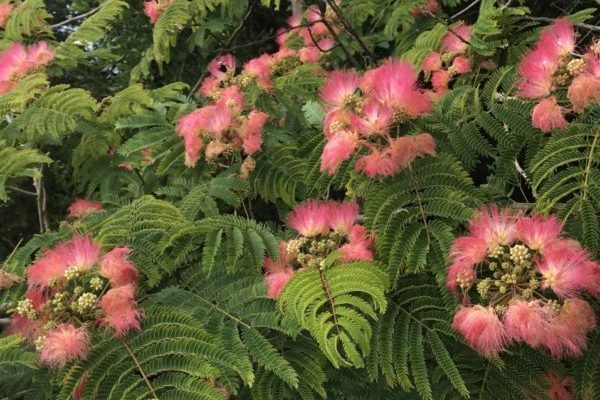
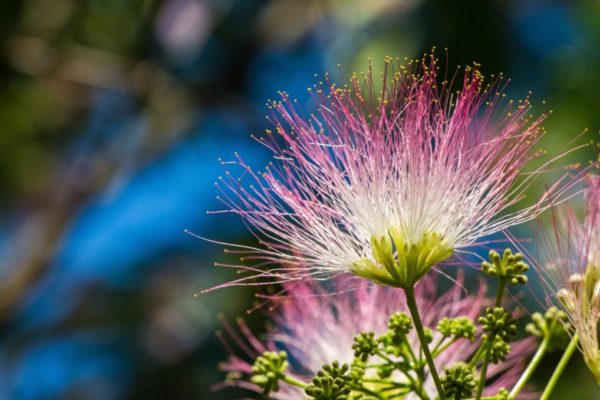
10
Albizia julibrissin
If you like the sight of hummingbirds, then the popular silk tree, also known as the mimosa tree, would make a great addition to your property’s landscape. Hummingbirds, bees, and butterflies absolutely love this tree’s uniquely-shaped, pink blooms. And even better, property owners love this tree for its total package. This is a tree that is not only stunning when it’s in bloom, but it’s also extremely hardy, fast-growing, and easy to care for.
Originating from China, the silk tree was brought to the United States in the mid-18th century, and now can be found in most states from coast to coast. It derived its name, silk tree, from its flower puffs that resemble silk threads. If you have ever traveled to Hawaii, this is a tree that brings a sense of familiarity because it looks nearly identical to its cousin, the monkeypod tree, which reigns as one of Hawaii’s most prominent trees. The silk tree possesses a tropical display and does very well in high temperatures. While it may not be the tropics, it still flourishes in the dry, hot summer months in San Diego. It may be a heat-tolerant and drought-tolerant tree, but being a tropical tree, if you want your mimosa to reach its highest potential, then it would be best to keep it on a regular, deep-water schedule.
In the late spring and into the summer months, the mimosa tree shifts into “bedazzle” mode when its pink blooms emerge. Unfortunately, as the saying goes, “All good things must come to an end.” It holds true with the silk tree. After its beautiful bloom season ends, the tree’s “ugly” season begins, as its gorgeous art show turns into a sad exhibit of 6-inch seed pods. Initially, it’s not too bad, but then the tree’s fern-like foliage drop when the temperatures begin to drop. Then in the winter, all that is left is a straggly, leafless tree with hundreds of drooping, brown seed pods.
As with any tree, when the silk tree is first planted in a new location, it goes through a shock period that can last a couple of years. You won’t see much action during this time. You won’t even see flowers. But once its roots get firmly established (typically 2-5 years), the tree quickly grows until it reaches its plateau height, which typically lands in the 20-30ft range. And after years of waiting, you’ll finally get to see those spectacular flower clusters. But before that happens, the tree needs to reach a certain level of maturity before it can produce flowers. In general, the mimosa typically doesn’t start producing blooms until it reaches a height of 10 feet.
LOCAL SAN DIEGO NURSERIES
Evergreen Nursery
Armstrong Garden Centers
Moon Valley Nurseries

NEED TREE TRIMMING OR REMOVAL SERVICES?
LC TREE SERVICE WOULD BE HAPPY TO HELP!
619.677.5777
The post 10 MOST COMMON FLOWERING TREES IN SAN DIEGO first appeared on San Diego Tree Trimmers – LC Tree Service.
